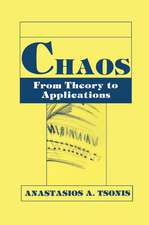An Introduction to Mathematical Epidemiology: Texts in Applied Mathematics, cartea 61
Autor Maia Martchevaen Limba Engleză Paperback – 23 aug 2016
| Toate formatele și edițiile | Preț | Express |
|---|---|---|
| Paperback (1) | 464.37 lei 6-8 săpt. | |
| Springer Us – 23 aug 2016 | 464.37 lei 6-8 săpt. | |
| Hardback (1) | 461.29 lei 3-5 săpt. | +35.31 lei 5-11 zile |
| Springer Us – 21 oct 2015 | 461.29 lei 3-5 săpt. | +35.31 lei 5-11 zile |
Din seria Texts in Applied Mathematics
- 17%
 Preț: 368.61 lei
Preț: 368.61 lei - 17%
 Preț: 364.42 lei
Preț: 364.42 lei -
 Preț: 494.87 lei
Preț: 494.87 lei - 19%
 Preț: 505.89 lei
Preț: 505.89 lei - 17%
 Preț: 498.74 lei
Preț: 498.74 lei -
 Preț: 463.79 lei
Preț: 463.79 lei -
 Preț: 471.91 lei
Preț: 471.91 lei - 13%
 Preț: 427.17 lei
Preț: 427.17 lei -
 Preț: 447.93 lei
Preț: 447.93 lei - 8%
 Preț: 528.53 lei
Preț: 528.53 lei - 19%
 Preț: 586.76 lei
Preț: 586.76 lei - 15%
 Preț: 461.29 lei
Preț: 461.29 lei -
 Preț: 404.13 lei
Preț: 404.13 lei - 17%
 Preț: 364.52 lei
Preț: 364.52 lei - 17%
 Preț: 363.12 lei
Preț: 363.12 lei - 15%
 Preț: 594.73 lei
Preț: 594.73 lei -
 Preț: 492.20 lei
Preț: 492.20 lei - 15%
 Preț: 606.82 lei
Preț: 606.82 lei -
 Preț: 406.25 lei
Preț: 406.25 lei - 15%
 Preț: 534.60 lei
Preț: 534.60 lei - 18%
 Preț: 1233.03 lei
Preț: 1233.03 lei -
 Preț: 404.13 lei
Preț: 404.13 lei - 15%
 Preț: 662.27 lei
Preț: 662.27 lei - 15%
 Preț: 511.70 lei
Preț: 511.70 lei -
 Preț: 404.89 lei
Preț: 404.89 lei -
 Preț: 399.29 lei
Preț: 399.29 lei -
 Preț: 464.00 lei
Preț: 464.00 lei - 15%
 Preț: 535.34 lei
Preț: 535.34 lei - 15%
 Preț: 681.60 lei
Preț: 681.60 lei - 15%
 Preț: 732.81 lei
Preț: 732.81 lei -
 Preț: 394.87 lei
Preț: 394.87 lei
Preț: 464.37 lei
Nou
Puncte Express: 697
Preț estimativ în valută:
88.89€ • 96.58$ • 74.71£
88.89€ • 96.58$ • 74.71£
Carte tipărită la comandă
Livrare economică 21 aprilie-05 mai
Preluare comenzi: 021 569.72.76
Specificații
ISBN-13: 9781489978325
ISBN-10: 1489978321
Pagini: 453
Ilustrații: XIV, 453 p. 103 illus., 60 illus. in color.
Dimensiuni: 155 x 235 mm
Greutate: 0.65 kg
Ediția:Softcover reprint of the original 1st ed. 2015
Editura: Springer Us
Colecția Springer
Seria Texts in Applied Mathematics
Locul publicării:New York, NY, United States
ISBN-10: 1489978321
Pagini: 453
Ilustrații: XIV, 453 p. 103 illus., 60 illus. in color.
Dimensiuni: 155 x 235 mm
Greutate: 0.65 kg
Ediția:Softcover reprint of the original 1st ed. 2015
Editura: Springer Us
Colecția Springer
Seria Texts in Applied Mathematics
Locul publicării:New York, NY, United States
Cuprins
Introduction.- Introduction to Epidemic Modeling.- The SIR Model with Demography: General Properties of Planar Systems.- Vector-Borne Diseases.- Techniques for Computing R0.- Fitting Models to Data.- Analysis of Complex ODE Epidemic Models: Global Stability.- Multi-strain Disease Dynamics.- Control Strategies.- Ecological Context of Epidemiology.- Zoonotic Disease, Avian Influenza and Non-autonomous Models.- Age-structured Epidemic Models.- Class-age Structured Epidemic Models.- Immuno-Epidemiological Modeling.- Spatial Heterogeneity in Epidemiological Models.- Discrete Epidemic Models.
Recenzii
“The current book is an introductory text that starts at the level of the neophyte and gradually brings the student to the level of current research. … The target readers include advanced undergraduate and graduate students in mathematics as well as graduate students in other fields. … This is an appealing book, well-written and thoughtfully organized.” (William J. Satzer, MAA reviews, maa.org, January, 2016)
“This book does not limit itself by any means to be just an introductory level textbook, aiming actually to be a comprehensive, self-contained reference text for mathematical epidemiologists. … The presentation is example-based, well thought out and very carefully organized. … The book has the clarity of a textbook while having the depth of a monograph, the author always being successful in conveying the content of a topic regardless of its difficulty.” (Paul Georgescu, zbMATH 1333.92006, 2016)
“This book does not limit itself by any means to be just an introductory level textbook, aiming actually to be a comprehensive, self-contained reference text for mathematical epidemiologists. … The presentation is example-based, well thought out and very carefully organized. … The book has the clarity of a textbook while having the depth of a monograph, the author always being successful in conveying the content of a topic regardless of its difficulty.” (Paul Georgescu, zbMATH 1333.92006, 2016)
Notă biografică
Maia Martcheva is a Professor in the Department of Mathematics at the University of Florida, USA. Her areas of interest and research include: epidemic models of multi-strain interactions, spatial epidemic modeling, immunological modeling, and immune-epidemiological modeling.
Textul de pe ultima copertă
The book is a comprehensive, self-contained introduction to the mathematical modeling and analysis of infectious diseases. It includes model building, fitting to data, local and global analysis techniques. Various types of deterministic dynamical models are considered: ordinary differential equation models, delay-differential equation models, difference equation models, age-structured PDE models and diffusion models. It includes various techniques for the computation of the basic reproduction number as well as approaches to the epidemiological interpretation of the reproduction number. MATLAB code is included to facilitate the data fitting and the simulation with age-structured models.
Caracteristici
A comprehensive introduction to mathematical epidemiology accelerating from beginner to advanced research level Provides detailed introduction to applied dynamical systems while linking to epidemiological concepts Uses data to complement model development and analysis? Highly illustrated with exercises included at the end of each chapter Includes code in MATLAB for simulations and fitting Includes supplementary material: sn.pub/extras


















